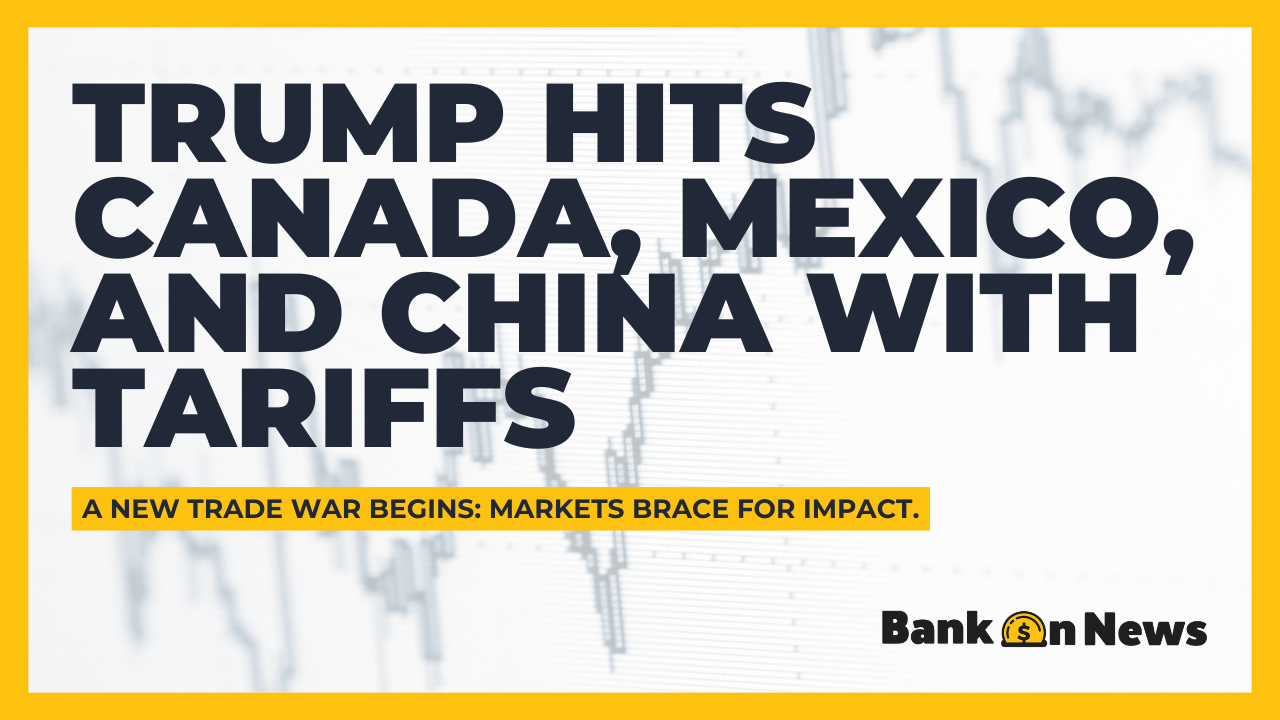🇺🇸 Trump Hits Canada, Mexico, and China With Tariffs. Markets Brace for Impact

Trump’s Tariff Hammer Drops—Is This the Start of a Global Trade War?
Global markets were rocked this weekend as President Donald Trump officially imposed 25% tariffs on Canada and Mexico and 10% tariffs on China. The move, announced Saturday, is already sending shockwaves through supply chains, corporate earnings forecasts, and consumer spending projections.
With trade relations thrown into chaos, economists are warning that we could be at the start of a major trade war—one that could fuel inflation, rattle the stock market, and strain U.S. businesses.
Will tariffs bring back American manufacturing, or will they backfire and slow economic growth? Let’s break down what this means for your portfolio, prices at the checkout, and the future of global commerce.
What These Tariffs Mean for the U.S. Economy
Unlike past trade skirmishes, this time, Trump’s tariffs hit all imports from Canada and Mexico with a massive 25% tax—covering everything from automobiles and machinery to food and consumer goods.
Meanwhile, China faces a 10% tariff, escalating ongoing tensions between the world’s two largest economies.
📌 Canada & Mexico (25% Tariff):
- A major blow to North American trade, potentially disrupting auto manufacturing, steel, agriculture, and retail.
- Expect rising prices on vehicles, groceries, appliances, and home goods.
📌 China (10% Tariff):
- Electronics, apparel, and batteries will see price increases.
- Tech giants like Apple and Tesla could feel the squeeze as manufacturing costs rise.
For American consumers, the key takeaway is simple: Things are about to get more expensive.
Will Tariffs Bring Inflation Back?
With the Federal Reserve already struggling to tame inflation, these tariffs could drive prices higher across the board.
🔺 Cars and Trucks: The auto industry depends on Canada and Mexico for parts and assembly. Expect sticker shock at dealerships.
🔺 Groceries: The U.S. imports billions in produce, meat, and dairy from Canada and Mexico—prices are likely to rise.
🔺 Electronics: Many smartphones, laptops, and batteries rely on Chinese components. Tariffs mean higher costs.
🔺 Clothing & Retail: With a tariff squeeze on materials, expect higher prices at stores like Walmart, Target, and Amazon.
For consumers, this is essentially a tax on everyday goods, with price hikes hitting middle-class and lower-income households hardest.
The Fed may have to keep interest rates higher for longer to counteract these inflationary pressures, making borrowing costs more expensive for mortgages, car loans, and credit cards.
Stock Market Reaction: Winners and Losers
Wall Street is already bracing for market turbulence, with certain sectors poised for gains while others face serious headwinds.
✅ Potential Winners:
- U.S. Steel & Aluminum Companies – Domestic producers could benefit as tariffs price out foreign competition.
- Defense & Security Stocks – A tougher stance on China may mean more government contracts.
- Commodity & Energy Stocks – Inflation-driven price increases could boost gold, silver, and oil.
❌ Likely Losers:
- Auto Manufacturers (Ford, GM, Toyota, Honda) – Higher production costs and declining demand could hurt margins.
- Retailers (Walmart, Target, Amazon) – Price hikes could slow consumer spending.
- Tech Companies (Apple, Tesla, Nvidia) – Heavily reliant on Chinese manufacturing, they face rising supply chain costs.
For investors, this means higher volatility and potential shifts in sector performance. Domestic-focused companies may outperform multinational firms with heavy foreign exposure.
Will Canada, Mexico, and China Retaliate?
Trade wars are never one-sided, and the U.S.’s top trading partners are likely to hit back with their own tariffs.
🇨🇦 Canada: Expected to respond with tariffs on American agriculture, energy, and industrial goods.
🇲🇽 Mexico: Could target U.S. auto exports, farming products, and manufacturing goods.
🇨🇳 China: Likely to retaliate with tariffs on American exports like soybeans, semiconductors, and energy.
This could be a replay of the 2018-2019 trade war, which caused market volatility, hit U.S. farmers hard, and slowed global economic growth.
How to Protect Your Portfolio
With uncertainty rising, investors need to be proactive in managing risk and seeking opportunities.
📈 Invest in U.S.-Focused Companies: Domestic firms that rely less on imports may be better positioned.
💰 Consider Defensive Stocks: Utilities, healthcare, and consumer staples tend to hold up in economic downturns.
⚡ Look at Commodities: Inflationary pressure could push gold, silver, and oil prices higher, making them smart hedges.
📊 Stay Diversified: Holding a balanced mix of stocks, bonds, and alternative investments can help manage volatility.
Bottom Line: Markets Are on Edge—What Happens Next?
Trump’s aggressive tariffs on Canada, Mexico, and China have thrown global trade into chaos and could trigger inflation, stock market volatility, and trade retaliation.
For businesses, higher import costs mean tighter margins and potential layoffs. For consumers, everyday goods are about to get more expensive. And for investors, this could be the beginning of a major market shift.
With global leaders weighing their next moves, the financial landscape is anything but certain—and we could be looking at the start of a full-scale trade war.
Do you think Trump’s tariffs will strengthen the U.S. economy or create more financial pain? Drop your thoughts in the comments!
Subscribe to our newsletter.
Be the first to know - subscribe today

